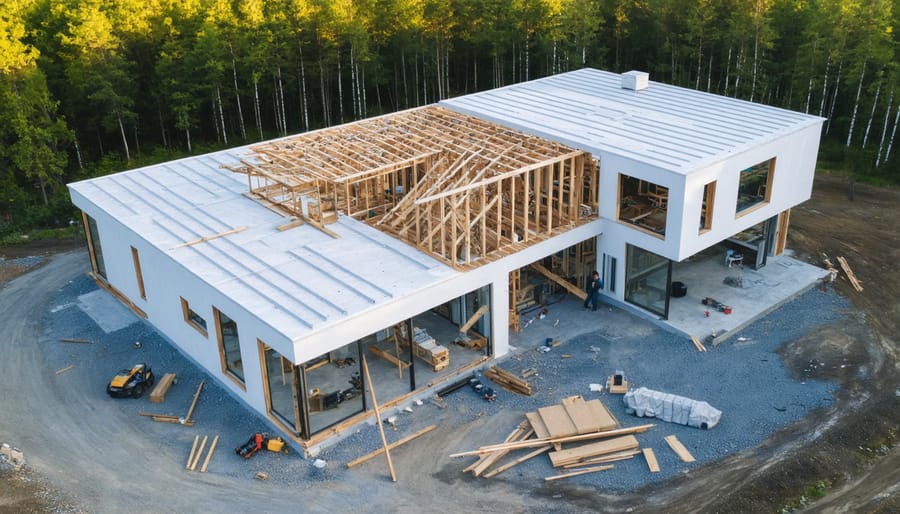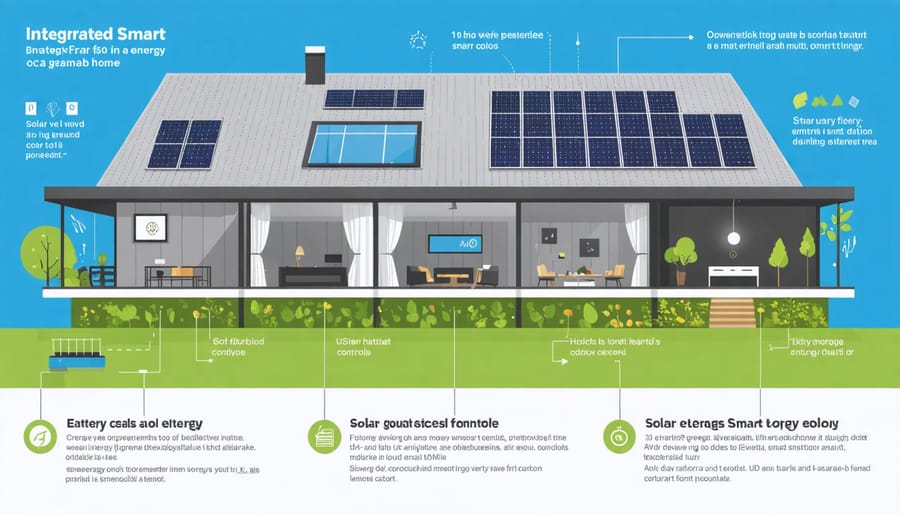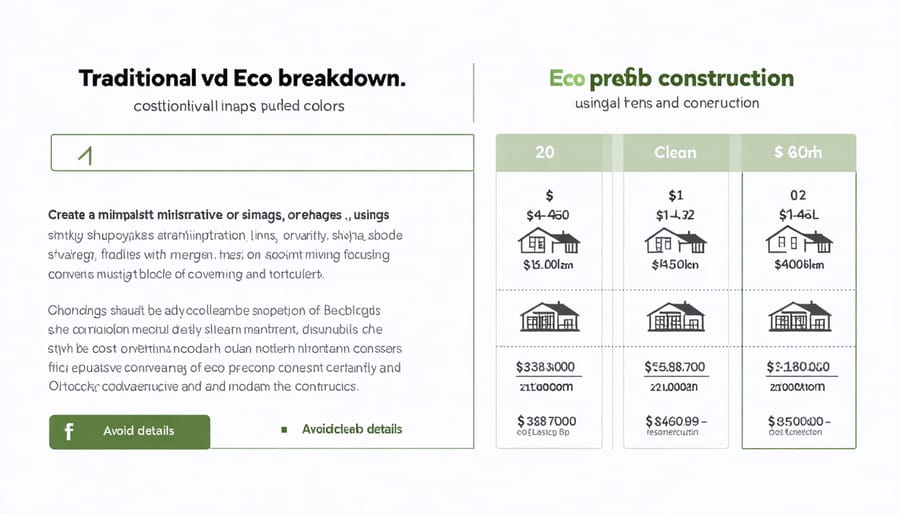Transform your vision of sustainable living into reality with eco prefab homes – the revolutionary approach to eco-friendly home design that combines environmental consciousness with modern efficiency. These precision-engineered dwellings slash construction waste by up to 90% while reducing energy consumption through advanced thermal engineering and smart material selection. Built in controlled factory environments, eco prefab homes emerge as complete units in weeks rather than months, featuring solar integration, rainwater harvesting systems, and sustainable materials that minimize environmental impact throughout their lifecycle. The fusion of cutting-edge manufacturing technology with sustainable principles delivers homes that not only shrink carbon footprints but also offer superior air quality, reduced utility costs, and enhanced durability compared to traditional construction methods. For homeowners seeking to embrace sustainable living without compromising on comfort or style, eco prefab homes represent the perfect intersection of environmental responsibility and modern living solutions.
Core Benefits of Eco Prefab Construction

Factory-Controlled Quality
Prefabricated homes are constructed in controlled factory environments where every component undergoes rigorous quality checks throughout the manufacturing process. Unlike traditional construction sites exposed to weather and varying conditions, these climate-controlled facilities maintain optimal conditions for materials and assembly. Advanced automation and precision machinery ensure exact measurements and cuts, minimizing waste and errors.
Each module passes through multiple inspection points, with trained quality control specialists verifying everything from structural integrity to insulation installation. Computer-aided design (CAD) systems guide the production process, ensuring consistency across all components. The factory setting also allows for better material storage, protecting building supplies from moisture and environmental damage.
This controlled environment enables manufacturers to maintain strict adherence to building codes and environmental standards. Workers specialize in specific assembly tasks, developing expertise that contributes to higher quality outcomes. The result is a more precise, durable, and reliable home compared to traditional on-site construction, with documented quality assurance at every step of the manufacturing process.
Waste Reduction Systems
Prefab construction significantly reduces waste through precise factory-based manufacturing processes. Unlike traditional construction, where up to 30% of materials often end up in landfills, prefab methods typically generate only 2-5% waste. This efficiency stems from computer-aided design (CAD) technology that optimizes material cuts and usage.
The controlled factory environment allows for sustainable waste management through systematic recycling programs. Excess materials from one project can be immediately repurposed for another, while standardized dimensions ensure minimal offcuts. Manufacturing multiple units simultaneously also enables bulk material purchasing, reducing packaging waste.
Modern prefab facilities incorporate advanced inventory management systems that track material usage and minimize overordering. Many manufacturers partner with suppliers who provide materials in exact quantities needed for specific projects. Additionally, weather protection in factory settings prevents material damage and waste from exposure to elements, a common issue in traditional construction sites.
This systematic approach to waste reduction not only benefits the environment but also contributes to cost savings, which are often passed on to homeowners.
Essential Eco Features in Modern Prefab Homes
Smart Energy Management
Modern eco prefab homes excel in energy efficiency through integrated smart energy management systems that optimize power consumption and reduce utility costs. Solar panels are typically pre-installed during the manufacturing process, ensuring optimal placement and seamless integration with the home’s electrical system. These photovoltaic systems can be sized according to household needs, with many models generating enough power to achieve net-zero energy status.
Advanced HVAC systems in eco prefab homes utilize heat pumps and energy recovery ventilators (ERVs) to maintain comfortable indoor temperatures while minimizing energy usage. Programmable thermostats and zone-based climate control allow residents to heat or cool specific areas as needed, further reducing energy waste.
Real-time energy monitoring displays provide inhabitants with detailed information about their power consumption patterns, enabling them to make informed decisions about their energy usage. Many systems include smartphone integration, allowing homeowners to adjust settings remotely and receive alerts about unusual energy consumption patterns.
The combination of solar power, efficient HVAC, and intelligent monitoring typically results in energy savings of 40-60% compared to traditional homes. These systems often pay for themselves within 5-7 years through reduced utility bills, while also qualifying homeowners for various energy-efficiency tax incentives and rebates.

Water Conservation Systems
Water conservation is a key feature of eco prefab homes, incorporating advanced water conservation methods that significantly reduce household water consumption. Rainwater harvesting systems are typically integrated into the home’s design, featuring gutters and downspouts that channel rainwater into storage tanks. These tanks can range from 1,000 to 5,000 gallons, providing a sustainable water source for irrigation, toilet flushing, and laundry.
Greywater recycling systems further enhance water efficiency by collecting and treating water from sinks, showers, and washing machines. This treated water can be safely reused for garden irrigation and toilet flushing, reducing freshwater consumption by up to 50%. Most eco prefab homes come with dual plumbing systems that separate potable and non-potable water lines, ensuring safe and efficient water distribution throughout the house.
Smart water meters and leak detection systems are often included, allowing homeowners to monitor water usage in real-time and identify potential issues quickly. Low-flow fixtures, dual-flush toilets, and water-efficient appliances complement these systems, creating a comprehensive approach to water conservation. These integrated solutions not only help protect valuable water resources but also lead to significant reductions in water bills and environmental impact.
Sustainable Materials
Eco prefab homes utilize a carefully selected range of sustainable materials that minimize environmental impact while maximizing durability and energy efficiency. Recycled steel frames serve as the primary structural component in many designs, offering superior strength while reducing the demand for new raw materials. These frames are often complemented by sustainably sourced timber, certified by organizations like FSC (Forest Stewardship Council), ensuring responsible forest management.
Insulation plays a crucial role in these homes’ eco-friendly design, with manufacturers favoring materials like recycled denim, sheep’s wool, or cellulose made from recycled paper products. These alternatives provide excellent thermal performance while avoiding the environmental concerns associated with traditional fiberglass insulation.
Exterior cladding options typically include reclaimed wood, fiber cement boards made from natural materials, or recycled metal siding. For interior finishes, eco prefab homes feature low-VOC paints, natural oils, and water-based sealants that maintain healthy indoor air quality. Flooring choices often include bamboo, cork, or reclaimed hardwood, all renewable resources that add both beauty and sustainability to the living space.
Windows and doors incorporate double or triple-pane glass with low-E coatings, while countertops and fixtures may be crafted from recycled glass, sustainably harvested stone, or reclaimed materials. Every material choice is evaluated not only for its environmental impact but also for its longevity and performance, ensuring that sustainability doesn’t compromise quality.
Real Cost Analysis

Initial Investment Comparison
When comparing eco prefab homes to traditional construction, the initial investment presents an interesting dynamic. While eco prefab homes typically require a higher upfront cost, ranging from $200 to $400 per square foot, traditional homes generally start at $150 to $300 per square foot, depending on location and specifications.
This price difference is primarily attributed to the high-quality sustainable materials and advanced manufacturing processes used in eco prefab construction. The integration of energy-efficient systems, such as solar panels, smart home technology, and superior insulation, contributes to the higher initial cost.
However, it’s crucial to consider that eco prefab homes often include features that would be expensive add-ons in traditional construction. These built-in elements, like energy-efficient windows, water conservation systems, and sustainable building materials, would significantly increase the cost of a conventional home if added separately.
Furthermore, the controlled factory environment where prefab components are manufactured reduces material waste and labor costs, partially offsetting the expense of premium materials. The shorter construction timeline also means reduced financing costs and earlier occupancy, providing immediate cost benefits.
When factoring in these considerations, the price gap between eco prefab and traditional homes becomes less significant, especially when viewing the investment from a long-term perspective. The higher initial investment typically translates to substantial savings in utility costs and maintenance over the home’s lifetime.
Long-Term ROI
Investing in an eco prefab home can yield substantial financial returns over time through reduced operating costs and enhanced durability. The average eco prefab home owner typically sees a 50-70% reduction in monthly energy bills compared to traditional homes, translating to savings of $1,200-$1,800 annually. Over a 20-year period, these energy savings alone can amount to $24,000-$36,000.
Solar panels and energy-efficient systems, while requiring an initial investment, usually pay for themselves within 5-7 years. High-quality insulation and airtight construction reduce heating and cooling costs by up to 40%, while smart home technology optimizes energy consumption patterns for additional savings.
Maintenance costs are significantly lower due to the quality-controlled manufacturing process and durable materials used. Eco prefab homes typically require 30% less maintenance over their lifetime compared to conventional builds. The use of weather-resistant materials and robust construction methods means fewer repairs and replacements are needed.
The resale value of eco prefab homes has shown consistent growth, with studies indicating a 10-15% premium over traditional homes in the same area. This appreciation is driven by increasing demand for sustainable housing and rising energy costs, making eco-friendly features increasingly valuable to future buyers. When factoring in energy savings, reduced maintenance costs, and potential property value appreciation, the total ROI over 20 years can exceed $100,000.
Making the Right Choice
When selecting an eco prefab home, several key factors deserve careful consideration to ensure you make the best choice for your needs and environmental goals. Start by evaluating the manufacturer’s sustainability credentials and certifications. Look for companies that use responsibly sourced materials and maintain transparent manufacturing processes.
Consider the climate and location where you plan to build. Different eco prefab designs perform better in certain environments, so choose a model that’s optimized for your area’s weather patterns and solar orientation. This ensures maximum energy efficiency and comfort year-round.
Size and layout requirements should align with your lifestyle while maintaining efficiency. Remember that smaller homes generally have a lower environmental impact and are more economical to maintain. However, clever design can make modest spaces feel larger through multi-functional areas and smart storage solutions.
Pay attention to the building materials and insulation options available. High-quality, sustainable materials might cost more initially but offer better long-term value through durability and energy savings. Look for homes featuring recycled materials, sustainable wood products, and non-toxic finishes.
Energy systems are crucial in eco prefab homes. Evaluate options for solar panels, heat pumps, and other renewable energy solutions. Consider whether the home can be adapted for future technological upgrades as sustainable solutions continue to evolve.
Check the manufacturer’s track record for customer service and after-sales support. A good company should offer comprehensive warranties and be willing to explain their construction process in detail. Ask about their quality control measures and delivery timeframes.
Finally, consider your budget carefully, including not just the initial purchase price but also transportation, site preparation, and installation costs. While eco prefab homes often cost less than traditional construction, prices can vary significantly based on customization options and features. Factor in potential energy savings and tax incentives when calculating the total investment.
Eco prefab homes represent a significant step forward in sustainable residential construction, offering a compelling blend of environmental responsibility and modern living. As we’ve explored throughout this article, these innovative homes deliver multiple advantages, from reduced carbon footprints and energy efficiency to faster construction times and cost-effectiveness over traditional building methods.
The future of eco prefab homes looks increasingly bright as more homeowners prioritize sustainable living solutions. With advancing technology and growing environmental awareness, manufacturers continue to innovate with new materials, improved construction techniques, and enhanced energy-saving features. The standardization of prefab construction processes also means these homes are becoming more accessible and affordable for a broader range of buyers.
The benefits extend beyond individual homeowners to impact entire communities and the environment. Lower construction waste, reduced energy consumption, and the use of sustainable materials contribute to a healthier planet. Additionally, the scalability of prefab construction makes it a viable solution for addressing housing needs while maintaining high environmental standards.
As building codes evolve and green building practices become more mainstream, eco prefab homes are positioned to play a crucial role in the future of residential construction. For those seeking a sustainable living solution that combines environmental responsibility with modern comfort and convenience, eco prefab homes offer an intelligent and forward-thinking choice that will only continue to improve with time.
